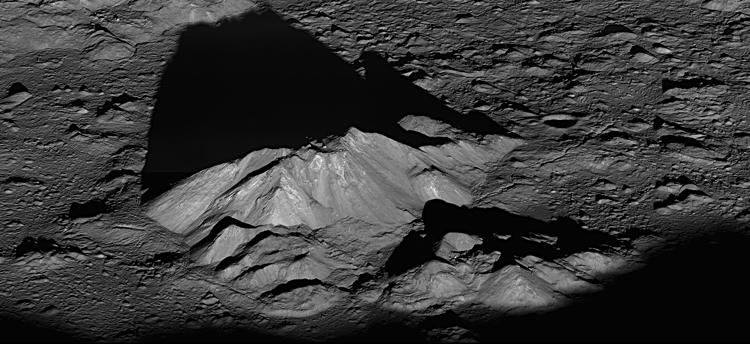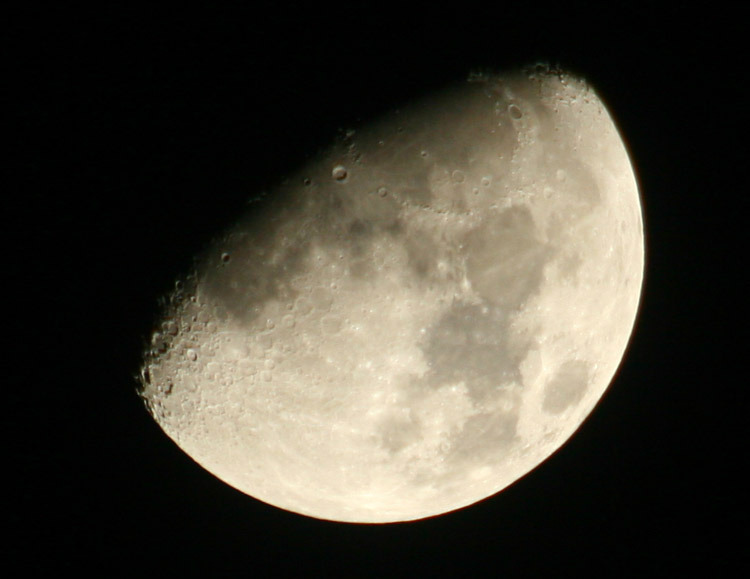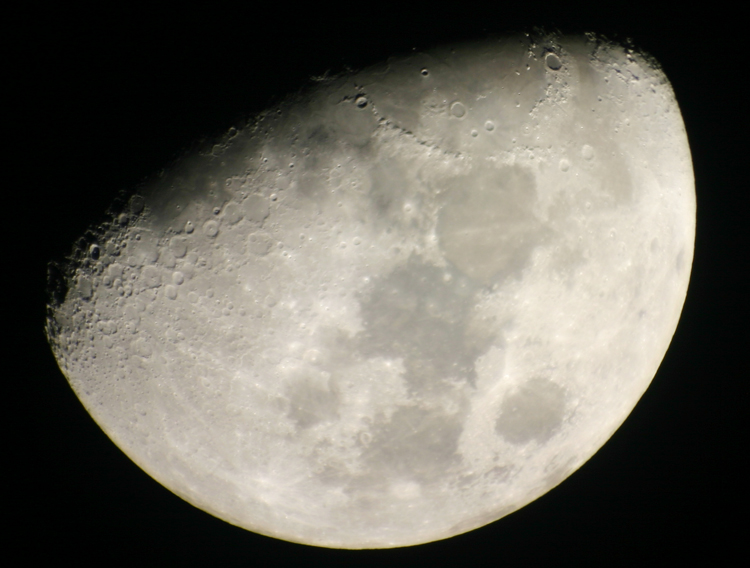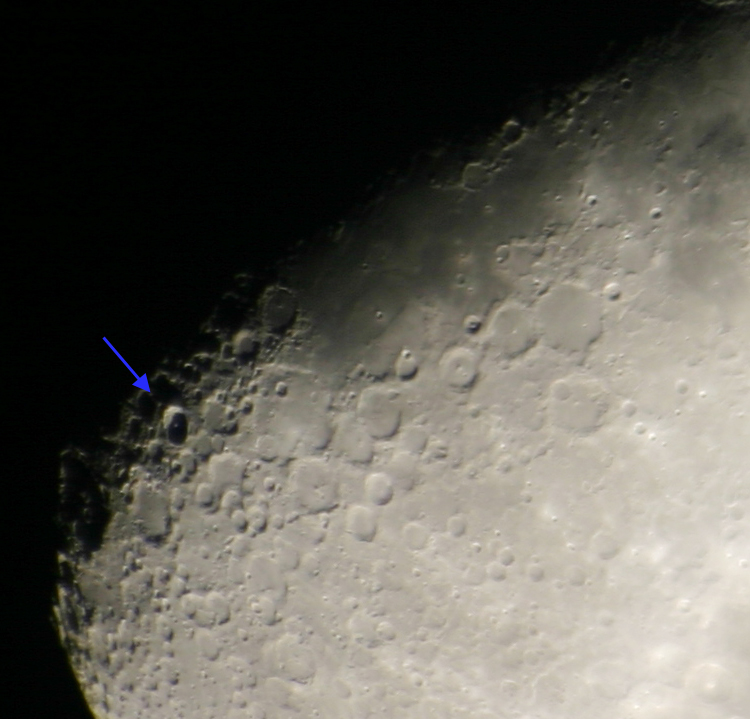So, I’ve mentioned before that I’ve wanted (for reasons too sordid to go into here where anyone could see it) to catch sunrise on the central peak in Tycho. Tycho is a crater on the moon, one of those where the impact debris formed a pile of rubble directly in the center of the crater, because physics. And of course, this little mountain will see the rising sun before the crater floor, which will be visible from Earth with a high enough magnification.
This is an image of that peak taken from the Lunar Reconnaissance Orbiter, but this is too late in the day – the crater floor is visible. That central peak is 1.6 kilometers (1 mile) in height, just so you know. There is a banana for scale at the base of the peak.

Now, the moon rotates a lot slower than Earth, each day there lasting 29.5 Earth days, so sunrise is a much slower affair. As a bit of trivia, each of the Apollo missions were timed for lunar morning, when they would have constant daylight but the moon’s surface would not have heated up too far to tax the equipment and astronauts – the temperature difference between day and night on the moon is hundreds of degrees (Celsius or Fahrenheit – doesn’t matter.) Anyway, capturing this sunrise event doesn’t quite require the exact timing of such an event on Earth, but it’s still a narrow window during one phase of the moon.
We’ve had some clear nights, and on February 23rd I observed the moon and thought, Maybe, and so set up the tripod and 170-500 lens to see what I could get. This is not quite enough magnification to see if the sun is touching that central peak, and in fact, pinning down Tycho itself is more than a little tricky. When you see the full moon it’s easy, because Tycho has that wonderful system of rays, a starburst of ‘ejecta’ (debris) from the impact, but they mostly extend towards the west side, which is not illuminated yet at the time I was aiming for. There are only two visible at Tycho sunrise, and they’re curving around enough that they can be hard to use as a guide; if it’s too early, even the crater walls of Tycho are shrouded in darkness, and with all of the craters in that region of the moon, it’s hard to know which one you’re actually looking at.

What happens is, I get the shot, trying hard both to nail the precise focus and to make out if that central peak is illuminated, then come back in, unload the card, and look at the full resolution image while trying to pin down enough landmarks to ensure I have the right crater.
By the way, Google Earth has a moon setting where you can see detailed photos of the moon, but it’s no help in the slightest: all of the images are taken during “high noon” for that region, throwing no shadows or shaping, so even telling certain craters apart is difficult. Like a lot of photographic subjects, the best results come from oblique light, the shadows providing the shapes and textures that make things interesting. So full moon shots are nice, but non-full phases like shown here have much more depth and relief.
Here’s a marked version. The blue arrow is Tycho, just a bit too soon so the central peak is still dark, while the yellow arrow is Eratosthenes, a crater at the end of the Apennine mountain range (Montes Apenninus,) that distinctive curved line of mountains easily visible with a long lens, decent binoculars, or a small telescope.

The reason that I mention the Apennines and Eratosthenes is that these are more visible and distinctive than Tycho, at this time of lunar day, and the appearance of Eratosthenes from the darkness indicates about the same happening for Tycho. And after getting this image and determining that I was a little too early, I wondered if the event might just occur in an hour or so. This is where I was unnecessarily stupid (like there’s a necessary level of stupidity,) because I neglected to check the time when the moon would disappear below the horizon and guesstimated it instead; when I went back out, I was too late.
The next day I did a couple of daylight shots of the moon (meaning our daylight, like late afternoon here) and followed up in the evening, confirming that I was too late.

And the marked version; again, blue for Tycho, yellow for Eratosthenes.

There is the faintest indication of that central peak, from both a brighter spot of the light reflecting more directly to us from the sides, and a darker spot from the shadow it throws; you can imagine that, at this magnification, even if I get the precise moment the focus better be bang on or it won’t show at all.
The other crater now visible to the left of Eratosthenes is Copernicus; with its high and sharp walls it shows up pretty well with magnification, leading to the common saying, “If you can see Copernicus, it’s too late for breakfast on Tycho.” So, yeah, missed sunrise again.
Now, as you’re rolling your eyes at my incompetence and thinking of reading someone else’s blog, let me tell you the rest of the story. Again, pinning down Tycho when you’re seeing it at the terminator (edge of shadow) can be tricky if you’re not intimately familiar with all of the craters on the moon, and Google Moon is no help; neither are most of the moon maps in existence, for much the same reasons. So one of my tricks is to take a full moon photo from my own stock, where Tycho is obvious, and overlay it onto the current image. This isn’t as simple as it sounds. Not only do both the size and the orientation have to be precise, requiring a lot of playing around in an editing program, the moon wobbles, and doesn’t show us the exact same face each night, so any chosen full moon shot might not match the face I just got, and no editing trick is going to fix that.
But as I was going through my folder seeing what pics might help, I came across a set of images taken back in 2009 when I had an 8″ Galilean telescope, experimental shots holding the camera without lens up the the empty eyepiece of the scope – much larger and more detailed than anything the 170-500 could manage. The orientation was different so maybe that’s why it escaped my attention then, but I stopped dead now and looked stupidly at the photo (orientation changed closer to other photos here.)

See it? I admit, it’s hard to make out at this resolution, meaning that in the viewfinder of the camera at the lower magnification of the 170-500, it would be impossible, but here’s a full resolution inset of the telescope image, with handy blue pointer again.

Yeah, that’s sunrise on Tycho’s central peak all right. And there are even some indications that I caught it almost as it occurred; I shot four images over seventeen minutes, and it appears to be getting brighter in each. So, for years I’ve had this as a goal, unaware that I’d captured it without intending to back during some experimental shots in the early days of the blog – in fact, ten days before what presently counts as the first post, but not really. It even got posted seven weeks later.
I ended up selling that telescope back when I needed the money, and in all honesty this isn’t a good area for astronomical observations, between the light pollution and humidity, but I still might get a smaller scope to use when the mood strikes – I like astronomy too much not to.



















































